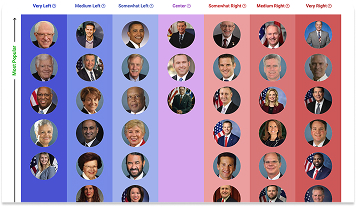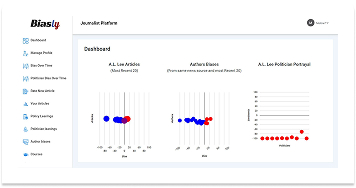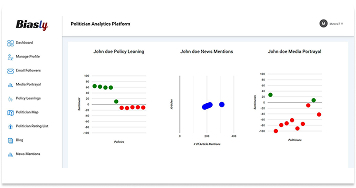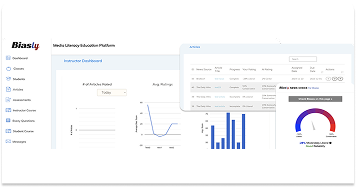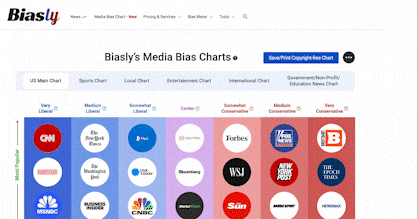Bias Meter
Extremely
Liberal
Very
Liberal
Somewhat Liberal
Center
Somewhat Conservative
Very
Conservative
Extremely
Conservative
-100%
Liberal
100%
Conservative

Biasly determines media bias ratings through a dual-layered approach combining artificial intelligence and analyst review. The platform’s proprietary bias detection engine, Bias Meter, evaluates sentiment, policy position alignment, and language framing across thousands of data points in news articles. Analysts then verify and interpret the AI’s findings, providing additional context where needed. Learn more
- Profile
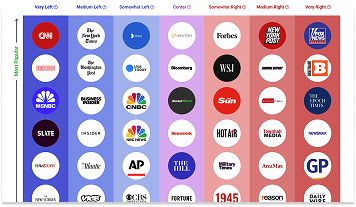
VeteransToday on the media bias chart
VeteransToday has a Bias Score of -84% Very Left which is based on a variety of factors including its policy and politician leanings, article ratings, and the use of biased language. Its Reliability is rated as Average, and additional analytical insights are available in the other tabs.
- Bias Rating
-84% Very Left
- ReliabilityPolicy Leanings
12% Somewhat Right
Extremely
LiberalVery
LiberalModerately
LiberalSomewhat Liberal
Center
Somewhat Conservative
Moderately
ConservativeVery
ConservativeExtremely
Conservative-100%
Liberal100%
Conservative
Average Reliability
*Our bias meter rating uses data science including sentiment analysis, machine learning and our proprietary algorithm for determining biases in news articles. Bias scores are on a scale of -100% to 100% with higher negative scores being more liberal and higher positive scores being more conservative and 0% being neutral. The rating is an independent analysis and is not affiliated nor sponsored by the news source or any other organization.
Politician Portrayal58% negative
Continue For Free
Create your free account to see the in-depth bias analytics and more.
By creating an account, you agree to our Terms and Privacy Policy, and subscribe to email updates.
Policy Leanings Analysis
Policy | Bias score |
|---|
VeteransToday’s Editorial Patterns
VeteransToday’s coverage of political topics often reflects Very Left bias, with consistent patterns in phrasing, source selection, and thematic focus that lean liberal. While the publication does not comply with mainstream journalistic standards, choice of issues and framing can indicate the extent of its political slant. This content analysis examines how VeteransToday handles liberal and conservative issues and evaluates its language choices and editorial tendencies.
Coverage of Liberal vs. Conservative Topics
VeteransToday shows a strong liberal bias, especially in foreign policy and international conflicts involving U.S. allies, such as Israel. It frequently covers adversarial nations, such as Iran or Russia, while criticizing U.S. and NATO military strategies harshly. Conservative perspectives, especially on defense or national loyalty, are underrepresented or excluded. This can result is one-sidedness without balanced counterpoints.
On domestic issues like abortion, immigration, or capitalism, VeteransToday leans moderately liberal but occasionally includes more balanced discussions. However, these topics receive less frequent coverage compared to international affairs and left-leaning geopolitical commentary. Articles often frame conservative policies as harmful, without fully addressing their intended rationale or support base.
The platform frequently omits conservative veteran views despite claiming to represent veteran interests. This contradicts national data showing most U.S. veterans lean conservative in political orientation and values. Such incongruencies raise concerns about VeteransToday’s editorial direction and its alignment with its target audience.
Policy and Issue Framing
VeteransToday often frames international and defense-related issues through a lens of anti-interventionism and skepticism toward Western alliances, particularly NATO and Israel. This aligns with its Very Left rating and positions the platform among outlets critical of U.S. foreign policy. Articles about military spending or international conflicts frequently highlight humanitarian consequences, civilian casualties, and critiques of Western ‘hegemony.’ This framing supports a narrative common in progressive discourse.
On domestic policy, issues such as healthcare, wealth inequality, and systemic racism are generally approached from a liberal stance. Such topics emphasize structural change and government accountability. However, VeteransToday articles tend to present gun rights or religious freedom, which typically align with conservative values, as problematic or dangerous. Readers will also find VeteransToday linking them to broader concerns about authoritarianism or militarism on a global scale.
Language choices play a critical role in how VeteransToday shapes its narratives. Progressive policies are described with terms like “justice,” “sovereignty,” or “resistance.” Conversely, opposing views are often framed as “imperialist,” “corporate-driven,” or “fascist.” This selective diction reinforces the site’s editorial identity, and even in articles lacking overt opinion, word choice and source selection subtly direct the reader toward a particular viewpoint.
Coverage and Relevance
VeteransToday frequently engages with core topics tied to media political bias. The platform addresses information, foreign influence, and the role of alternative media in shaping public opinion. Its unique positioning as a veteran-centered yet Very Left outlet makes it a notable case for examining types of bias. Journalist bias, editorial framing, and bias in news media can be found among niche or politically distinct readerships.
The platform’s controversial U.S. foreign policy coverage, affiliations, and lack of editorial oversight make it central in news bias discussions. For readers wanting to explore how VeteransToday compares with other publications across the spectrum, Biasly’s Media Chart can be helpful.
VeteransToday Bias Analysis
Is VeteransToday Biased?
Based on Biasly’s evaluations, VeteransToday is rated as Very Left.
VeteransToday is a media platform developed in 2003 by a group of Veterans. The founders’ mission was to shed light on alternative foreign policy views and reach diverse audiences. Specifically, U.S. veterans and military personnel aligned with the founder’s background and interests. Today, Chief Justin Time manages the website. VeteransToday’s base in the U.S. encourages American views despite its decentralized operating structure and international staff. It covers a wide range of topics, including Politics, Government, Military, World, and Health news. Readers stimulating an average of 56,135 visits per month rank the platform 33,683 among other media sources.
How Does Biasly Rate News Sources?
Biasly uses proprietary algorithms and a team of analysts to provide comprehensive bias evaluations across thousands of news outlets. Over 200,000 articles from more than 3,200 sources have been analyzed to identify the most accurate and unbiased stories.
Biasly assigns each outlet three key scores:
- Reliability Score – Reflects factual accuracy
- AI Bias Score – Generated via natural language processing
- Analyst Bias Score – Assessed by human political analystsThese scores are based on seven core metrics: Tone, Tendency, Diction, Author Check, Selection/Omission, Expediency Bias, and Accuracy. These elements help analysts and algorithms evaluate the political attitude conveyed by each article.
Biasly’s Bias Meter ranges from -100% (most left) to +100% (most right), with 0% indicating neutrality. The system evaluates individual articles based on political terms, policies, figures, and sentiment to calculate precise bias ratings.
Is VeteransToday Politically Biased?
VeteransToday earns Very Left rating for its AI Bias Score and Medium Left for its Analyst Bias Score. The Analyst Bias Score is generated by reviewers from liberal, moderate, and conservative backgrounds. Analysts reviewed 15 VeteransToday articles and noted preferences in areas like coverage of left-wing foreign policy interests and global conflicts involving genocide. However, the paper displays more objectivity in discussions over strategic warfare and weapons.
When covering domestic issues such as abortion, border control, and competitive capitalism, VeteransToday has a moderate bias. The site’s coverage of international topics, such as global intervention and Israel, however, reveals a strong to extreme liberal media bias.
The platform specifically values topics and opinions of veteran or military interests. Interestingly, its left-leaning editorial choices stand in stark contrast to the political identities and concerns of most U.S. veterans. A 2024 Pew Research study found that 63% of military veterans identify with or lean toward the Republican Party, showing a strong conservative orientation. 72% of White veterans in particular lean Republican (Pew Research Center, 2024). While VeteransToday claims to represent veterans’ voices, its content often diverges from the broader veteran demographic’s political tendencies.

Source: Pew Research
Research published in Social Science Quarterly further reveals that veterans, especially those with combat experience, develop strong veteran identities that shape their policy views, often overriding party affiliation. These identities typically emphasize national loyalty, defense readiness, and a distrust of foreign adversaries.
VeteransToday’s publishing of articles praising adversarial regimes like Russia’s, or amplifying disinformation, appears out of step with those policy preferences.
These inconsistencies suggest that readers should approach VeteransToday with skepticism and cross-reference its claims with more rigorously vetted sources. VeteransToday appears to acknowledge its editorial limitations. According to its disclosure:
“Due to the nature of uncensored content posted by VeteransToday’s fully independent international writers, VeteransToday cannot guarantee absolute validity. All content is owned by the author exclusively. Expressed opinions are NOT necessarily the views of VeteransToday, other authors, affiliates, advertisers, sponsors, partners, or technicians. Some content may be satirical in nature. All images are the full responsibility of the article author and NOT VeteransToday.”
Such disclaimers reinforce VeteransToday’s identity as a blog, not an objective news source. Its structure discourages editorial oversight and amplifies biased news under the semblance of free speech.
Readers must therefore engage with strong media literacy education when interpreting VeteransToday articles. The gap between VeteransToday’s editorial direction and veteran political data shows how even veteran-focused outlets can misrepresent their audience’s identity. Readers seeking the best news sources or clarity through a media bias chart should treat VeteransToday cautiously. Let’s dive into some of their articles to identify some of these biases.
Analysis of Bias in VeteransToday Online Articles
VeteransToday has found that in-depth coverage of the Israel-Palestine conflict is one of the most effective ways to drive subscriptions. Given that much of its readership is liberal-minded, using political terms and references often coined by the Democrat Party, it is essential to ask: is VeteransToday truly biased?
To evaluate this, we can analyze select VeteransToday articles through several of Biasly’s bias rating criteria: Tone, Tendency, Author, Diction, and Expediency Bias.
- Tone: The overall attitude conveyed by the article
- Diction: Specific word choices made by the writer
- Author: The background and social presence of the journalist
- Tendency: Patterns of bias in the writer’s broader body of work
- Expediency Bias: Quick visual or textual indicators like headlines and photos that imply bias

Source: VeteransToday
An example of VeteransToday’s liberal reporting is found in the article, “Iran is preparing to launch massive strikes against US military facilities in the Middle East.” Carisio captures readers’ attention with a dramatic image depicting Trump in front of what appears to be an explosion. He also uses text features to describe the Republican president as a “criminal,” in capital letters. The headline, while more neutral, focuses speculation before offering facts. This impresses urgency and fear upon readers.
The article opens with claims from Iranian media about drone and missile attacks on U.S. targets in the region. Words like “massive strikes” and “direct aggression” show strong diction that draws out instinctive reactions. One of the strongest examples of charged language comes from the author rather than a source or official.
“Once again, a mad criminal at the command of a world atomic power has betrayed the promise.”
This sentence carries distinctive emotion, depicting Trump as reckless and dangerously unpredictable on a global scale. Iranian officials are also reported to have responded with terms of equal intensity, such as “brutal assault” and “irreversible consequences.”
This offers balanced coverage of both parties’ views. Each government uses highly emotional language and makes claims that are evidently intended to intimidate the opposition. However, when dialogue surrounding conflict appeals to readers’ morals, it is even more crucial to provide objective reporting.
The article primarily relies on Iranian media and unnamed senior officials, without providing satellite imagery, military assessments, or official statements from neutral parties. This absence of verified data forces readers to rely on the language and forecasts presented here, rather than on clear facts. Including such data would allow readers to form their own judgments rather than be led by alarmist tones.
In another article, “Israel has let the genie out of the bottle,” Israel is the primary focus. The title is critical of Israel and, consequently, its Western allies. This one-sided framing aligns with liberal, ‘anti-imperialist’ viewpoints common among critics of U.S. and Israeli foreign policy.
Criticism of U.S. leadership is pointed. Calling Secretary Rubio’s denial “farcical” and Trump’s strategy “insane” reveals a strong oppositional stance. The author calls Israel’s attack a “crime of historic proportions” without presenting Israel’s perspective or security concerns. He says with further decisiveness,
“Netanyahu has just gifted Iran the legal path to nuclear weapons.”
The article portrays Iran as a victim acting within “international legality.” While the article cites the NPT’s Article 10, it does not follow up with equally recognized statements supporting Israel’s defensive decisions. This encourages readers to support Iran’s position without question.
Additional social media posts by the author, Resta, can be found on VeteransToday’s account under the hashtag #claudioresta. Here, the journalist frequently shares edited or AI-generated images that convey misleading information about world leaders.
Resta emphasizes Israel’s human rights violations but downplays Iran’s controversial nuclear ambitions and human rights record. As he redirects attention to human rights, he also fails to mention Iran’s role in global human rights concerns.
Failing to offer comprehensive coverage highly limits the article’s objectivity. Readers should approach the article critically and seek multiple sources for a more comprehensive understanding.
Analysis of VeteransToday Opinion Articles
To fully understand political bias in media, it’s important to distinguish between factual reporting and opinion pieces. While reporting aims to present facts and let readers form their own conclusions, opinion articles express personal viewpoints on current issues. VeteransToday is unique in its lack of editorial oversight. The freedom the platform offers journalists allows for more opinion in its informative pieces. This blurs the line for readers trying to distinguish between informative articles and opinion articles. In this section, we will turn to how bias surfaces through VeteransToday articles where opinion is especially prevalent.
In one article, Ahmed Adel writes that “Trump’s tariff policy will lead Southeast Asia to a future without US influence.” Though placed in a geopolitics column, this is clearly an opinion piece. The headline does not make its claim through a direct quote and prioritizes analysis over direct reporting of events.
The author’s Cairo background is reflected in critiques of U.S. policy that align more with liberal foreign policy views. Writers at VeteransToday often express skepticism of U.S. influence, especially corporate power abroad. This article is certainly included in that stance, encouraging readers to question U.S. policy. Readers should watch for slippery slope reasoning and bold claims without clear evidence in opinion pieces like this.
A different author writes, “The dark forces in control of the Anglo-American-Zionist Empire are the Source of the World Crisis.” Cook writes with highly charged and conspiratorial language. Its title signals a strong bias and blames a supposedly secretive, controlling group for global events. The piece relies on disjointed, cherry-picked history as the major evidence. It directly blames the government for modern terrorist groups without credible sources. Such claims contradict the U.S.’s official military position on terrorist organizations.
VeteransToday displays strong media bias through tone, selection bias, and emotionally charged headlines. Though it claims to support U.S. veterans, its articles often oppose U.S. government actions and policies. Its anti-establishment stance aligns more with liberal media bias than with traditional veteran values or unbiased news sources. This inconsistency suggests deeper bias, especially when opinion replaces reporting, and facts are blurred with speculation. Readers should apply media literacy skills and use tools like bias meter to evaluate claims.
Who Owns VeteransToday?
VeteransToday is an independent media platform known for strong political bias and minimal editorial oversight. Since 2023, it has been owned by Chief Justin Time. The site was originally founded in 2004 by Johnny Punish, a retired U.S. newspaper professional. Now hosted on WordPress, VeteransToday aims to provide a censorship-free space for global contributors to share viewpoints often absent from mainstream media.

Source: VeteransToday
The former senior editor and chairman of the board, Gordon Duff, is a prolific proponent of anti-Israel conspiracy theories. Gordon Duff left an observable impression on the platform’s belief-driven approach to journalism. He published claims linking 9/11 and U.S. policies to Israeli intelligence, contributing heavily to the site’s controversial reputation.
All VeteransToday’s content is written by unpaid, independent writers. VeteransToday emphasizes that it does not employ staff journalists or editors and receives no funding from sponsors, governments, or media partners. The platform is funded entirely by reader donations and advertising, positioning VeteransToday as an alternative to corporate-owned outlets.
VeteransToday’s structure promotes media freedom but raises concerns about accuracy, misinformation, and media bias. The site does not fact-check content, leaving full responsibility to individual writers. This challenges readers to apply media literacy skills to identify bias in media and question whether the content qualifies as news or opinion.
How to Evaluate Bias
Although Biasly rates VeteransToday as Very Left, it’s important to remember that bias can vary from article to article. VeteransToday also covers a field of politics extending outside of the U.S, and strives for diversity in its staff. This complexity underscores the importance of examining each article individually.
Recognizing media bias requires awareness and critical thinking. Often, readers trust news sources that affirm their existing beliefs—a psychological tendency known as confirmation bias. This makes it harder to identify slanted narratives or one-sided reporting.
To combat this, it’s essential to challenge your assumptions by consulting multiple viewpoints and verifying news through third-party analysis. Tools like Biasly’s media bias ratings allow readers to compare the same news story across the political spectrum.
Ultimately, bias isn’t always a matter of what is said—it’s also about what is left out, how topics are framed, and which stories are chosen for coverage. Learning to recognize these patterns can help readers make more informed decisions and develop greater media literacy.
To start comparing news outlets and gain a better understanding of bias, sign up for Biasly’s Media Bias & News Analytics Platform to see how stories vary between sources.
VeteransToday Reliability Analysis
Is VeteransToday Reliable?
VeteransToday takes place on the low end of the accuracy spectrum, with Average reliability. A 2024 Pew study found 40% of social media news users cited inaccuracy as their top concern—a 9-point rise since 2018. Veterans, often active on social media, are especially vulnerable to such misinformation, including foreign disinformation campaigns. Considering the platform’s focus on foreign policy, existing relations between the U.S and foreign entities must be carefully considered. A Congress report on U.S. veterans’ vulnerability online through propaganda and identity spoofing is relevant for readers of VeteransToday. VeteransToday claims no official sponsors, but its writers maintain outside media ties, according to the site’s Policies and Disclosures.
Very little is known about VeteransToday’s writers; most profiles lack professional bios, credentials, or social media links. Writers also frequently use AI-generated images, which can reflect bias or inaccuracies due to flawed training data. AI systems often amplify existing stereotypes or inaccuracies when dataset gaps exist, yet outputs still appear factual and credible.
How to Evaluate Reliability?
Reliability refers to how trustworthy or accurate a news source is. If we can’t trust what we read, then continuing to consume content from that outlet serves little purpose. So how do we evaluate a news outlet’s reliability?
There are several potential measures of reliability to look out for when trying to determine whether a media source is reliable or not. Red flags for an unreliable article can include the presence of wild, unsubstantiated claims, facts dependent on other unreliable sources, heavy use of opinionated language, and more. In contrast, hallmarks of a reliable source include:
- Absence of subjective language
- Citing credible sources (e.g., .gov, .edu, academic references)
- Verifiable facts and statistics from multiple outlets
- Use of primary sources, like interviews or transcripts
- Consistency with coverage across other platforms
Biasly’s reliability scores incorporate these elements in evaluating media outlets.
So How Does VeteransToday Fare in Its Reliability?
The political reliability index developed by Biasly assesses both accuracy and trustworthiness. VeteransToday currently holds Average Reliability Score, which is calculated as a weighted average of:
- Fact Analysis Score – Evaluates the accuracy of claims, facts, and evidence.
- Source Analysis Score – Assesses the number, diversity, and credibility of sources and quotes used.
VeteransToday Source Analysis Score is rated Average at 58%. This suggests moderate trustworthiness in its sourcing practices. The score is AI-generated and considers quote length, frequency, diversity, and quality.
The Fact Analysis Score has yet to be finalized. This score will further determine how well VeteransToday supports its claims, addresses selection and omission bias, and presents verifiable evidence. Until this is available, readers are encouraged to perform their own evaluations using Biasly’s media bias tools.
While VeteransToday presents itself as independent, limited transparency and questionable sourcing reduce its reliability and trustworthiness for veteran audiences. These issues highlight the need to evaluate each article carefully, especially given veterans’ increased risk of being targeted by disinformation.
VeteransToday’s Accuracy and Reliability
According to Biasly’s analysis, VeteransToday maintains Average Reliability Score, but individual articles may vary significantly. Let’s dive into the details.
Political orientation plays a crucial role in how audiences perceive reliability. VeteransToday has been accused of favoring a liberal narrative and publishing to appease external partners. To validate such claims, it’s essential to analyze whether the publication backs its assertions with sufficient evidence and diverse viewpoints.
Two common types of bias that affect factuality include:
- Selection Bias – Highlighting or omitting stories to fit a particular narrative.
- Omission Bias – Leaving out differing perspectives or relevant details to skew perception.
Biasly’s accuracy ratings use a scale from 1% (least accurate) to 100% (most accurate). Factors include the presence of supporting evidence, internal and external reliable sources, and balanced viewpoints.
For instance, Biasly gave the Military Times an Average Analyst Reliability score. The Publication has one article titled, “Trump administration plans to cut 80,000 VA employees, memo says.” While the author included multiple quotes and sources, his coverage of opposing views was limited. Sentiments toward government regulation and impeachment reflect conservative views, but do not appear to disrupt overall objectivity. A different article by Military Times titled, “Trump orders return to old, Confederate-linked names for 7 Army sites,” attracts a more conservative audience. The Military Times article reports Trump’s plan to revert Army base renamings from the Biden administration. The report frames the reversal as routine rather than politically motivated.
It informs readers of new honorees. However, it shows omission bias by excluding opposition voices to this controversial conservative move. Trump said,
“We won a lot of battles out of those forts… It’s no time to change.”
This quote explains his view, but no critics are included to balance coverage. The article ignores responses from civil rights groups and lawmakers supporting the renamings. This omission downplays the strong controversy around the issue. Although factually accurate, it subtly favors the conservative decision through omission bias.
Conversely, VeteransToday reports with bias through explicit phrasing, appearing more flagrant in its favoritism towards specific groups. VeteransToday published an article titled “Europe ‘fears’ Trump’s victory and laments Kiev’s potential loss of support.” The language here portrays Israeli military actions as deliberate massacres, ignoring any security or defense context. Words like “shady business” and “Zionist regime” suggest a conspiratorial tone more concerning than the omission of neutral or opposing sources.
Analysis of Reliability in VeteransToday’s Online News Articles
VeteransToday aims to create a space where individuals can diversify the media through alternative views. Its value for diversity is reflected in its multi-national volunteer staff. However, readers should distinguish between news reporting and opinion pieces to evaluate credibility effectively.
Adel displays his effort to inform VeteransToday readers in his article, “UN Human Rights chief expresses concern over ban on political parties in Bangladesh as Islamism rises.” The author relies heavily on the UN official’s words and refrains from excessive commentary. He also provides brief context for the political landscape in which the story takes place. This piece’s focus on humanitarian effort aligns with the platform’s Very Right bias. However, in using dry language and first-hand sources, the author strives for objectivity and a neutral presentation.
Quality of Sources and Facts Used
VeteransToday often uses public statements by politicians, as they are readily available for analysis. The article “US targeting Spain for its relationship with Beijing and low military spending” employs numerous voices to discuss diplomatic autonomy. It offers useful context on Spain’s trade and defense position, helping readers understand tensions with both Washington and Brussels. While mildly skeptical of U.S. pressure, the author avoids alarmism and presents their concerns in a measured, informative tone. The piece still displays some bias, however, as the author concludes with his own interpretation.
The article draws mostly from government officials and agencies from Spain, the U.S., and the European Union. Quotations are short to medium and often paraphrased, which keeps the writing accessible but limits first-hand perspective. Still, the consistent use of official sources gives the article a reliable, fact-based foundation.
Sources referenced in the article:
- Carlos Cuerpo, Spanish Minister of Economy
- Scott Bessent, U.S. Treasury Secretary
- U.S. Treasury Department statements
- U.S. Department of Transportation statements
- Sean P. Duffy, U.S. Secretary of Transportation
- European Commission (digital services tax)
- Valdis Dombrovskis, European Commissioner for Trade
The piece interprets both Spain’s and America’s positions towards Trump’s decision on tariffs. Adel does not balance his analysis with that of experts or opposing voices. Including more independent analysis would limit the liberal media bias and appear less concerning to journalist bias analytics. What’s presented is coherent and grounded in official discourse.
The article aims to present the diplomatic friction without sensationalism or strong bias. However, bold claims toward the end lack the quality of evidence that the author initially presented the story through. He says,
“US pressure also stems from Spain’s insufficient defense spending, which Washington exploits to try to fragment the EU’s joint response to the tariffs.”
Politicians often make bold accusations in their public dialogue. Journalist striving for objectivity can use these opportunities to complement their reporting with information from external, unbiased sources. While VeteransToday claims to go against mainstream media, this article conforms to commonly seen hasty conclusions surrounding political dialogue in media. Defense spending and tariffs are highly nuanced topics, requiring many levels of analysis. Adel’s conclusion reflects VeteransToday’s tendency to criticise U.S. actions through words like “exploit.”
Overall, VeteransToday displays a tendency to use sources from:
- Government officials and ministries (e.g., U.S. Treasury, Spanish Ministry of Economy)
- International institutions (e.g., United Nations, European Commission)
- Official press releases and public statements
Political party spokespeople or opposition leaders (often quoted directly) - Limited or no inclusion of independent analysts, academics, or non-governmental experts
While these are reliable sources, foreign policy is highly nuanced and often determined by actors with hidden agendas. Readers seeking to be more informed of foreign policy and veteran news must take extra caution to conduct individual research. VeteransToday’s limited representation of voices often emphasizes criticism of the U.S. foreign policy agenda. Readers can practice media literacy by cross-examining information and using a variety of sources in their research.
Selection and Omission Bias
VeteransToday appeals to the interests of Veterans or any audiences interested in U.S. foreign policy developments. However, the presentation of current events suggests the reporting of stories from clear sides of the partisan divide.
VeteransToday’s article, “Formerly ‘pacifist’ Trump still insists on 5% GDP military spending for NATO,” extensively critiques the president. His push for NATO members to raise defense budgets to 5% of GDP also emphasizes negative economic and geopolitical consequences. However, the omission of any discussion of the strategic rationale behind NATO’s military spending targets other perspectives. Including voices that argue to enhance collective security through increased defense spending would be a valuable addition. There is also no exploration of potential benefits from stronger NATO capabilities or viewpoints from NATO officials defending the spending goals.
The article strongly criticizes Trump’s military and NATO policies, showing clear political bias that readers should recognize. It uses facts about defense spending and NATO strategy, but frames the story from a critical viewpoint. Checking news bias ratings and media literacy resources can provide helpful context and clarity.
So, Is VeteransToday Reliable?
Overall, VeteransToday can be considered to be moderately reliable outlet. The site often prioritizes opinion-driven content, with variable sourcing and occasional editorial framing on sensitive international topics. While some claims are supported with evidence, consistency in sourcing and balance could be improved to meet stronger journalistic standards.
As media literacy improves, spotting selection bias, omission bias, and factual issues becomes easier. To better assess political bias in news, use tools like Biasly’s news bias checker or side-by-side comparisons. These resources help reveal how news bias, framing, and source selection can influence reporting across outlets. By comparing stories, you gain stronger insight into media bias ratings and journalist bias analytics.
This builds your ability to find balanced, accurate, and trustworthy information in a polarized media landscape.
Additional Insights
News Source Comparison
Media focused on foreign policy spans a wide ideological spectrum. Outlets differ on defense budgets, human rights, and immigration policies. Perspectives can range from pro-military to anti-interventionist. This variety affects coverage of wars, diplomacy, and U.S. global influence. Readers must evaluate how each outlet frames international issues. Media literacy is crucial for understanding such ideological differences.
VeteransToday often shows extreme bias in foreign policy reporting. Its language favors anti-Western and conspiratorial narratives. In contrast, outlets like Military Times use more measured tones and factual reporting. Still, it may show omission bias by excluding opposing views. Military Times serves a conservative-leaning veteran audience with moderate reliability. VeteransToday appeals to alternative voices but favors liberal voices. Its sourcing is often weak and ideologically driven. Compared to mainstream outlets with more editorial oversight, VeteransToday prioritizes messaging over accuracy.
Notable Contributors and Authors
VeteransToday’s authors can be found on the platform’s staff page. Chief Justin Time manages daily operations, while Jonas Alexis and Dr. Kevin Barrett serve as senior writers from South Korea and Morocco. Notable past figures include site founder Johnny Punish and longtime editor Jim W. Dean. Its advisory board features voices like Mark Dankof, a former political candidate and conservative radio host, and Dr. Alan Sabrosky, an expert in security affairs. The outlet’s correspondents span countries like Italy, Pakistan, Egypt, and the UK, highlighting its strong global author base, despite being based in the U.S.
Related Tools and Resource Pages
To better understand how VeteransToday fits into the broader media landscape, we recommend exploring these helpful resources:
- Media Bias Chart: See where VeteransToday ranks among hundreds of media outlets across the political spectrum.
- Political Bias Chart: Visualize political slants of news sources across various policy areas.
- Journalist Bias Analytics Platform: Explore how individual journalists contribute to bias within their publications.
- Politician Bias Analytics Platform: Compare how politicians are framed differently by VeteransToday and other outlets.
Media Literacy Education Platform: Learn how to critically assess media sources, bias techniques, and news reliability.
Frequently Asked Questions
VeteransToday is rated as Very Left based on Biasly’s media bias algorithm, which assesses sentiment, article framing, and policy favorability.
VeteransToday has also come under scrutiny for its foreign media affiliations in the past. A 2017 Politico article notes VeteransToday’s partnerships with foreign state-run outlets, including Iran’s PressTV and Russia’s New Eastern Outlook. One reporter described the partnership with Russia as a “marriage made in heaven.” Kate Starbird, a University of Washington professor studying VeteransToday’s role, described the site as an “active partner” in spreading Russian propaganda. She highlighted its strategic targeting of active and retired U.S. military personnel. Additionally, VeteransToday’s former chairman, Gordon Duff, admitted in a 2012 interview that “about 30% of what’s written on VeteransToday is patently false,” and that approximately 40% of his own writing is “purposely, partially false,” indicating an intentional dissemination of misinformation.
This alignment raises red flags for media bias analytics software and news bias checker tools, especially when the platform claims to promote U.S. veteran interests.
Biasly uses a combination of AI sentiment analysis and human analyst review to assess tone, fact accuracy, source quality, and media bias indicators. Learn more on our Bias Meter page.
According to Biasly, VeteransToday is a source with limited reliability for fact-based reporting. Due to the platform’s lack of censorship, individual writers have full freedom to present contested terms and unverified claims. The site openly acknowledges this and encourages readers to report misinformation or hateful content. However, considering limited moderation and response time, readers should approach VeteransToday articles with caution and critical thinking.
Ratings are based on recent news using data science and A.I. technology.
Military Spending
| Date | Sentiment | Associated Article | Snippet |
|---|---|---|---|
| 08/25/2019 | 75% For | Trump Family Detentions Flores Agreement (link) | So, of course, the Trump administration is doing the opposite in a baldfaced |


























